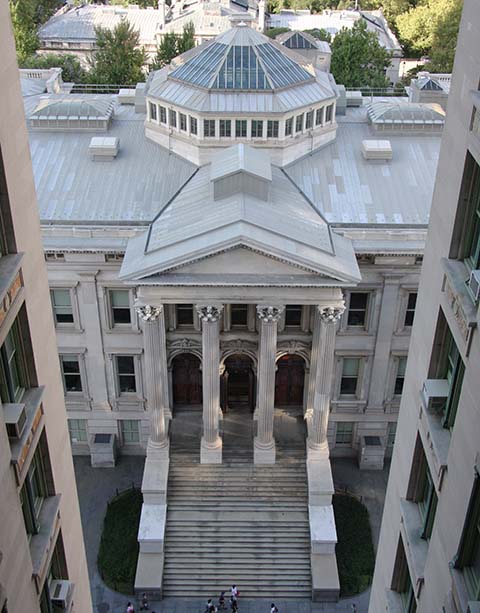
 Department of Citywide Administrative Services311
Department of Citywide Administrative Services311 Search all NYC.gov websites
Search all NYC.gov websites
Tweed Courthouse

New York, NY 10007
Date Built: 1861-1881
Architect: John Kellum (1809-1871) and Leopold Eidlitz (1823-1908)
"… one of the city’s grandest and most important civic monuments."
-- NYC Landmarks Preservation Commission, in its 1984 designation decision
The old New York County Courthouse, commonly known as Tweed Courthouse, is located on the north side of City Hall Park, behind City Hall, on Chambers Street between Centre Street and Broadway.
The courthouse was the first permanent government building erected by the City after the completion of City Hall. The building is notable not only for the unparalleled artistry of its design and decoration, but also for its association with one of New York’s greatest political scandals.
The three and one-half story building sits on a low granite curb with a rusticated marble basement. The building is composed of a central section with two projecting wings, with an addition in the center on the south facade. The entrance is marked by a pedimented portico supported by four Corinthian columns. The windows have arched and flat stone pediments. There is a massive stone cornice and an octagonal skylight at the roof, replacing a planned dome.
The architectural style of the Tweed Courthouse is American Victorian, a neo-classical style popular in the U.S. during the 19th century. A major feature is its interior octagonal rotunda, which is capped by a skylight. The rotunda extends from the first floor to the roof. On the east and west sides of the rotunda are sets of cast iron stairs that run from the first to the third floors. The "marble" pillars on these floors are really made of plaster and the "wood" railings are actually cast iron.
The exterior of the building and sections of its interior -- the rotunda, stairhalls and staircases, rooms 201 and 202 (the latter, a former courtroom), and the skylight -- are designated New York City landmarks.
The building’s architectural wonders are the product of two prominent 19th century New York architects, John Kellum and Leopold Eidlitz. Credit is also given to Thomas Little, a member of the New York City Board of Supervisors, whose name appears with Kellum’s on a small box placed beneath the cornerstone.
Construction began after the City of New York awarded a commission to design the building to Long Island native John Kellum in December 1861. A carpenter and self-taught architect, Kellum contributed to such historical landmarks as the Cary Building (105-107 Chambers Street) and the Alexander T. Stewart mansion (5th Avenue at 34th Street). Kellum set out to improve one of New York City’s great historical sites, demolishing a large poorhouse while clearing the crowded north side of City Hall Park.
Kellum died in 1871, and German architect Leopold Eidlitz, notable for his work on the New York State Capitol building, was hired in 1876 to finish the project. Eidlitz contributed important architectural ideas to the courthouse, including to the south wing and the domed rotunda enclosing the central courtyard. He added elements in the Romanesque style, especially in his use of brick and stone which blended with Kellum’s cast-iron interiors.
The courthouse is the legacy of Tammany Hall boss William M. Tweed (1823-1878), who used the construction project to embezzle large sums of money from the budget. In 1873 “Boss” Tweed was tried and convicted in an unfinished courtroom in this building and sentenced to 12 years in prison. Afterwards construction proceeded at a very slow pace and it was not until 1881 that the courthouse was finally completed.
The New York County Supreme Court used the space until 1929, and then the building housed the City Court until 1961, when that court moved to 111 Centre Street. After that, the former courthouse was used as a municipal office building.
In 1999, an extensive two-year restoration began to return the building to its original grandeur. Outside, marble cornices were replaced and leaf detail on the Corinthian columns was rebuilt. A new roof was designed to replicate the original, which was discovered to have been made of metal, and skylights were restored. The grand entrance stairway, which had been removed during World War II for the widening of Chambers Street, was rebuilt with the addition of 17 new Vermont granite steps.
Inside successful efforts were made to use original ventilation shafts in the building's walls, so that modern heating, ventilation, and air conditioning systems would intrude as little as possible. As many as 18 layers of old paint were removed from walls and cast iron, revealing both the detail in the cast iron, and the multi-colored pattern of painting on the brick walls. This and other historic painting schemes were replicated, and marble and glass-tile floors were reconstructed.
Today the building serves as the headquarters of the Department of Education. In keeping with this use, the ground floor was configured for use by public school students, first as a City Hall Academy for visiting student groups, and later as a full-time school.
The building has been seen in a number of film productions including The Verdict, Dressed to Kill, Kramer vs. Kramer, and Gangs of New York.
The courthouse was designated as a New York City Landmark in 1984. It is also listed on the New York State and National Registers of Historic Places.


